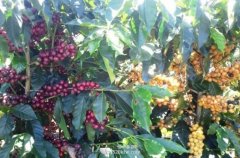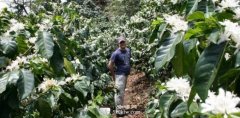Classification and selection of coffee trees

Arabica Coffee and Variety improvement
1. Varieties of Arabica species
What does the so-called "family, genus, species" mean in biological classification? In terms of biological classification, from top to bottom, they are "realm, phylum, class, order, family, genus and species", and the lower part of "species" is subdivided into subspecies, varieties and varieties. Arabica coffee is generally considered to be originated from the Ethiopian plateau, widely distributed in the tropics, after repeated mutation and breeding, derived many varieties. Now, it is said that there are more than 70 varieties of Arabica coffee alone. The so-called "variety", in the case of rice, is the difference between Thai rice and northeast China rice. There are many kinds of coffee, just like rice. At the same time, coffee is the same as rice in variety improvement, which constantly seeks to improve disease resistance, production and environmental adaptability. In addition, rice also pursues variety improvement in taste. On the other hand, coffee pays less attention to this point in order to pursue production efficiency, and the improvement of the quality of coffee taste has become a secondary goal, and there is even a suspicion of "getting worse". However, the market is still paying more and more attention to high-quality coffee, that is, high-quality coffee. Coffee producers and consumers are constantly introducing new quality evaluation standards. Coffee, which is highly rated and can be bought and sold at a high price, is an inherent variety of wet Arabica species (or "old tree"), such as Typica, Bourbon, Kaddura (bourbon mutant), and so on. Among today's varieties, the traditional varieties have the lowest yield and disease resistance, but their rich flavor is irreplaceable.
Several main coffee varieties and their characteristics
Tibica (Typica)
This is the closest Arabica species to the original species, and almost all Arabica species are derived from this. Used to be widely cultivated in Central and South America, the bean shape is long and has excellent aroma and sour taste, but it is not resistant to leaf rust and requires a considerable number of shading trees, resulting in low production (like bourbon, it can be harvested only once every two years). Colombia planted Tibica until 1967, and now 80% to 90% of them have switched to Kaddura, which is highly productive and resistant to direct sunlight, or a variant of Colombia. At present, there are very few pure Tibica in the coffee market in Colombia.
Bourbon (Bourbon)
Tibica is the best secondary species closest to the original species of Arabica, while bourbon is the second species caused by Tibica mutation. These two are the oldest varieties of coffee in existence. Bourbon was transplanted from Yemen to the eastern part of Madagascar in East Africa, then to the island of Bourbon in the Indian Ocean (now known as Reunion), and then into Brazil with French colonists. It is characterized by small and round beans, most of which are dense and gregarious, so the central line is S-shaped.
The harvest of bourbon is 20% and 30% higher than that of Tibika, but less than other high-yield varieties, and it is only harvested once every two years, so it is gradually replaced by other varieties. Bourbon hybrids and mutants such as Mundo Novo and Catuai are of high quality in aroma and alcohol thickness, and all have the characteristics of Tibica.
Kaddura (Caturra)
This is a bourbon mutant found in Brazil with low tree height, small bean grains, high yield and resistance to leaf rust. The disadvantage is that it will only bear fruit in the coming year, that is, it will only be harvested once every two years. Although the quality is very high, the cost of care and fertilization is quite high, which is suitable for cultivation in the middle and highlands with an altitude of 450 to 1700 meters and an annual rainfall of 2500 to 3500 millimeters. It is characterized by sour taste and slightly stronger astringency.
Mondo Norwood (Mundo Novo)
A natural hybrid of bourbon and Sumatra found in Brazil. Strong environmental adaptability and resistance to diseases and insect pests, although it is a high-yield variety, but the growth rate is slow, and the bean grain is too large. The tree height of more than 3 meters is its disadvantage (this height has exceeded the height that the harvester can reach, so it is not suitable for the mechanization of coffee harvesting), the top branches and leaves of the coffee tree should be trimmed every year. It was planted in Brazil around 1950 and is now the main variety in Brazil along with Kaddura and Kaduai. Mondonovu has a good balance of sour and bitter taste, and its taste is close to the original variety, so it was sought after as soon as it was launched, and it was named "Mundo Nove" (New World).
Kaduai (Catuai)
A hybrid of Mondo Novo and Kaddura. The yield is high and the environment is adaptable, and the tree is high and high (because the tree of Montanovu is too high, it is difficult to harvest, so it is crossed with Kaddura of tree height). Unlike Kaddura, Kaduai bears fruit year after year. Although it must be fully fertilized, it is resistant to diseases and insect pests, and the fruit is not easy to fall in the face of strong wind and rain. However, its fruit growth and harvest life is only about ten years, and its weakness is that the life span is too short. It is mainly cultivated in the vast area from Colombia to Central America. The taste of Kaduai is more monotonous and less mellow than Montanovo.
Marago Gippe (Maragogype)
This is a mutant of Tibica found in Brazil. The beans are large and need to be filtered with a sieve of more than 19. The taste is a little poor, but the appearance is good, so it is favored by some markets. The tree is on the high side, so the yield is low.
Kent (Kent)
Indian breed. It has high yield and strong resistance to diseases, especially leaf rust. It is thought to be a hybrid of Tibica and other varieties.
Amaret O (Amarello)
Generally speaking, the fruit of coffee appears red when it is ripe, but the fruit of this variety is just as its name (Amarello comes from the modern Latin Amprellus, meaning "yellow"), and the fruit is yellow when ripe. The yield is high because of the height of the tree.
Cartimo (Catimor)
Born in Portugal in 1959, Timor, a hybrid of Arabica and Robsta, was mated with bourbon mutant Kaddura. For the commercial varieties with high yield, it has the best mesophytic length and the highest yield. The height of the tree is low, and the fruits and seeds of coffee (raw beans) are on the large side. There are quite a number of new varieties derived from Cartimo. Generally speaking, the varieties of the Cartimo series are strong, adaptable to the environment and high in yield. Only in terms of taste, the low-real estate Cartimo is not far different from other commercial varieties, but the Katimo produced in the highlands above 1200 meters by the sea is obviously at a disadvantage compared with Bourbon, Kaddura, Kaduai and so on.
Mutant Columbia (Variedad Colombia)
The high disease-resistant variety produced by cross between Cartimo and Kaddura is resistant to direct sunlight and can be harvested in a short time. Colombia began to plant widely in the 1980s, replacing the previous inherent variety Tibica as the main variety. Generally speaking, Arabica coffee trees such as Tibica must be shaded by shading trees, but the mutant Colombian coffee trees with 1/4 Robusta pedigree do not need shading trees and can be produced and harvested throughout the year. It is just that in recent years, it may be due to the influence of pesticides or chemical ingredients, coffee beans will give off a carbonic acid smell (Phenol, similar to the odor of iodine). The difference with the inherent variety Tibica can be seen at a glance through deep baking (Fullcity Roasting). Generally speaking, after deep roasting, the sour taste of coffee weakens and the bitterness increases, while the bitter taste of the mutant Colombian coffee increases sharply after the second burst period.
two。 Variety improvement and its solving problems
The historical track and direction of variety improvement in various coffee producing countries are listed below.
a. High yield
b. Dwarf coffee trees (the trees are too high to harvest)
c. High disease resistance (especially varieties that are resistant to leaf rust)
d. Short-term harvest (in the past, varieties could only be harvested in three years at the earliest, and there were also varieties that could be harvested in a year or two)
e. Simultaneous results (short harvest time, efficiency)
f. High environmental adaptability (especially resistant to frost)
g. Good appearance (large granules of coffee beans)
h. Taste good
Why is the variety improvement of coffee always centered on hybrids (mainly Robusta hybrids)? The main reason is that coffee-producing countries are mainly developing countries, which have earned foreign exchange from coffee since the 17th century, so in any case, the most important thing is to ensure a certain annual harvest, reduce risk and increase the planting of hybrids. To enhance economic strength.
Important Notice :
前街咖啡 FrontStreet Coffee has moved to new addredd:
FrontStreet Coffee Address: 315,Donghua East Road,GuangZhou
Tel:020 38364473
- Prev

Understand the development history of coffee in China
According to historical data, Taiwan's cultivation was successful for the first time in 1884. Coffee trees were planted in China, and coffee cultivation on the continent began in Yunnan. In 1902, seeds were introduced by a French missionary named Tian in Yingong, Binchuan County, Yunnan Province. it was successfully planted in a place called Zhu Kula, which is located on the bank of the Yushan River, a tributary of the Jinsha River. The commercial cultivation of coffee in Yunnan began in 1985, but it has grown.
- Next

Understanding coffee leaf rust
The most destructive disease of coffee trees is Hemileia vastatrix. The disease has long occurred in coffee-producing regions such as Africa, the Near East and India, Asia and Australasia, and first appeared in the Western Hemisphere in 1970. The once-thriving coffee plantations of Sri Lanka and Java were destroyed there
Related
- What documents do you need to go through to open a coffee shop? coffee shop coffee shop certificate processing process
- How to purchase Coffee beans in small Cafe how to choose a suitable supplier for domestic Coffee supply Company
- How to drink Starbucks Fragrance White Coffee? how to make Australian White Coffee? what Italian coffee beans are recommended?
- The Story of Flora Coffee: the name of Flora Coffee Bean and the implication of the Flowers on Florna Coffee
- How much does a cup of coffee cost? How much is the profit of a cup of coffee? What is the profit of the coffee shop in a year?
- Yunnan small Coffee, known as "fragrant Coffee", introduces the characteristics of Alpine Arabica Coffee producing areas in Yunnan, China
- 2023 latest Starbucks full menu price list how much is a cup of Starbucks coffee what is better to drink the most popular hot and cold drinks recommended
- Starbucks different kinds of Coffee Price list Starbucks menu 2023 Top Ten Best drinks in Starbucks
- Starbucks Spring praise Comprehensive matching Coffee Bean theme Story Packaging implication and taste description
- The cost of a cup of coffee latte American coffee cost price and selling price

